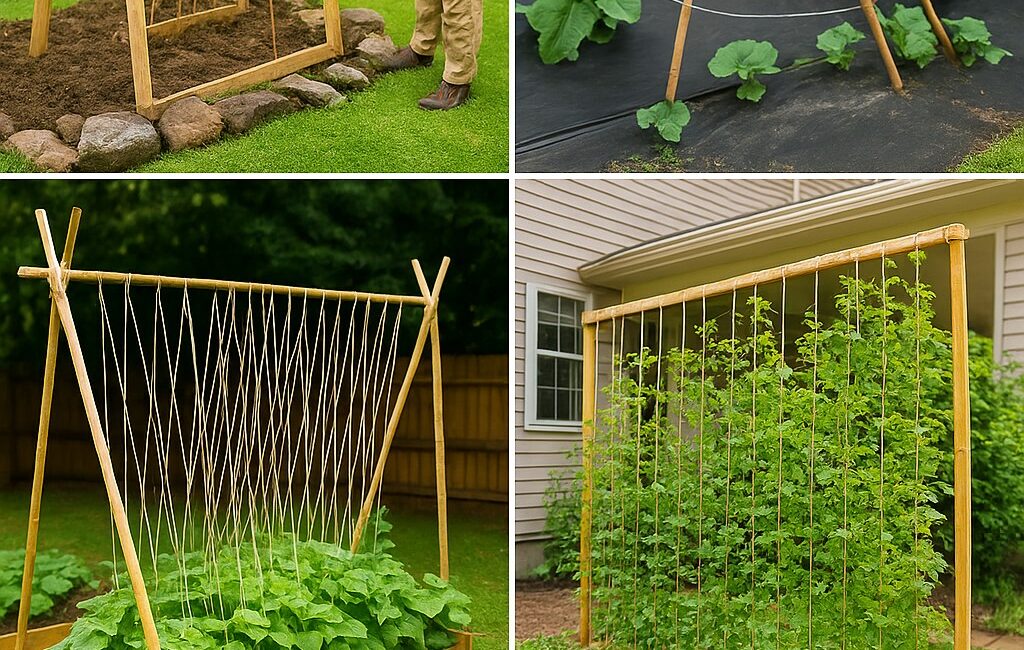Growing cucumbers is one of the most rewarding experiences for gardeners, whether you have a large backyard, a small urban plot, or even just a container on your balcony. Cucumbers are prolific producers, crisp, refreshing, and perfect for fresh eating or pickling. But they can also be quite sprawling plants, with long, vining growth habits that need room to roam. That’s where a cucumber trellis comes in—a simple gardening tool that can transform your cucumber growing experience, improving yield, plant health, and garden aesthetics.
In this comprehensive article, you’ll discover why a cucumber trellis is an absolute game changer, how it benefits your garden, and detailed instructions to build six different types of DIY trellises suitable for every budget and space. We’ll also cover essential growing tips to ensure your cucumbers thrive when grown vertically.
1. Why Use a Cucumber Trellis? Key Benefits Explained
Saves Space in Your Garden or Container
Cucumber plants naturally sprawl across the ground, taking up a lot of horizontal space. If you have a limited garden area, this can mean fewer plants and a less efficient use of your space. Growing cucumbers vertically on a trellis allows the vines to climb upward instead of sprawling sideways. This vertical growth habit saves valuable ground space, making it ideal for small gardens, raised beds, balcony containers, or urban settings.
Vertical gardening also lets you grow more plants per square foot since the vines don’t crowd each other on the ground. For gardeners looking to maximize production in a confined area, a trellis is indispensable.
Prevents Rot and Pests by Lifting Fruit Off the Soil
One of the common problems when cucumbers grow along the ground is that the fruits rest on the soil surface. This direct contact with moist soil makes cucumbers vulnerable to rot, fungal infections, and pest damage.
When you use a trellis, cucumbers are suspended in the air, away from damp soil, which helps:
- Keep the fruits dry and clean.
- Prevent diseases like powdery mildew and fruit rot.
- Reduce damage from slugs, snails, rodents, and insects that dwell at ground level.
This leads to healthier cucumbers and less waste, increasing your overall harvest quality and quantity.
Encourages Healthier Plants with Better Airflow
Good airflow around your plants is crucial to prevent fungal diseases and encourage strong growth. When cucumbers sprawl on the ground, leaves and stems can become crowded and damp, creating the perfect environment for mold, mildew, and blight.
A trellis lifts the vines into a vertical position, allowing sunlight and air to circulate freely around the foliage and fruit. This natural ventilation helps keep plants dry and healthy, reducing the need for chemical fungicides or constant manual inspection.
Makes Harvesting Easier and More Efficient
Cucumbers that grow on the ground can be hard to spot among dense foliage. Plus, bending down or crawling through sprawling vines can be uncomfortable and time-consuming.
With a trellis, cucumbers hang visibly on the vine, making it much easier to:
- Spot ripe fruits ready for picking.
- Reach and harvest without bending over or disturbing the plant.
- Monitor plant health and growth regularly.
This ease of harvest encourages frequent picking, which can stimulate the plant to produce even more cucumbers throughout the season.
2. How to Choose the Right Cucumber Variety for Trellising
Before we dive into trellis designs, it’s important to select cucumber varieties that are well-suited for vertical growing.
Vining Cucumbers
Most cucumbers are vining types that naturally climb when given support. These varieties are ideal for trellises. Examples include:
- Marketmore
- Lemon Cucumber
- Pickling varieties
They tend to produce long, slender fruits and benefit the most from vertical support.
Bush Cucumbers
Bush varieties are more compact and do not require trellising. Examples include:
- Bush Champion
- Patio Snacker
If space is very limited or if you prefer low-maintenance plants, bush cucumbers are good. However, they generally yield less and take up more ground space compared to vining types.
3. Six Easy DIY Cucumber Trellis Ideas
You don’t need fancy tools or expensive materials to build an effective trellis. Here are six easy and practical ideas to get you started, complete with what you need, how they work, and bonus tips.
3.1 A-Frame Trellis
What You Need
- Wood stakes or PVC pipes (four pieces, 5-6 feet long)
- Screws or zip ties
- Garden twine or wire mesh
How It Works
The A-frame trellis consists of two rectangular panels joined at the top to form a triangle (like a tent). The panels create two vertical climbing surfaces where cucumber vines can grow upward on both sides.
To build:
- Join two stakes at the top with a hinge or screw to form one side of the A.
- Repeat for the other side.
- Connect the two sides at the bottom with cross supports.
- Attach wire mesh or run horizontal lines of twine across each panel every 6-8 inches.
- Place the trellis in your garden or container and plant cucumbers at the base of each side.
Bonus
You can plant shade-loving vegetables like lettuce or spinach underneath the A-frame, as it provides some partial shade, making the most of vertical and horizontal space.
Click page 2 for more




